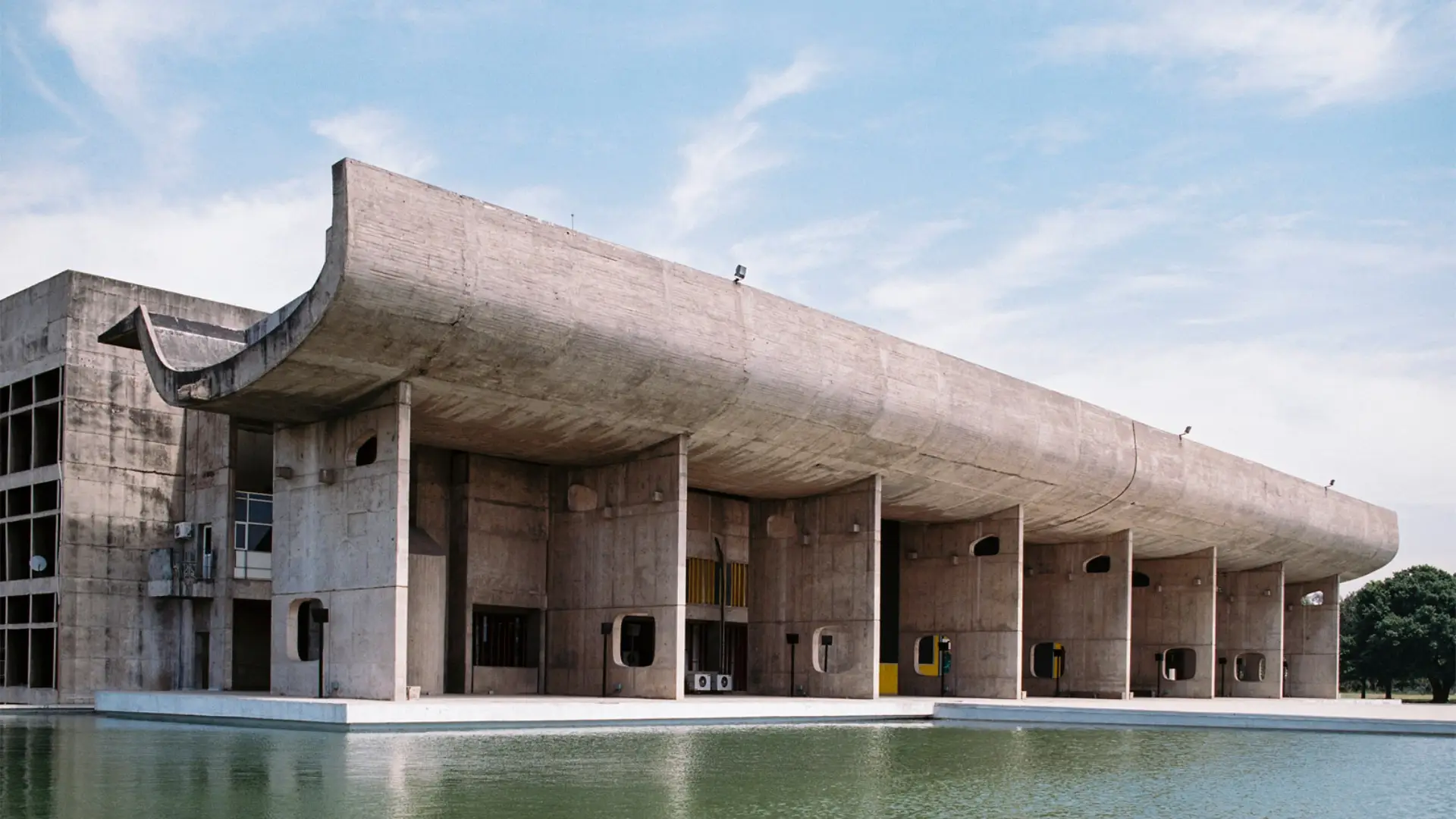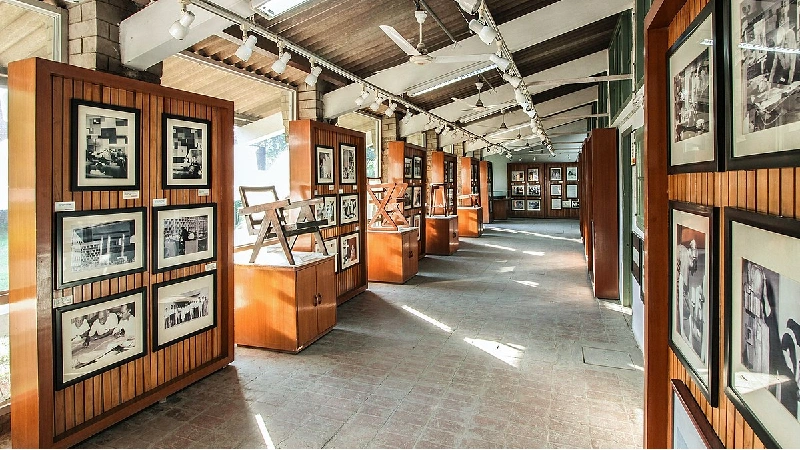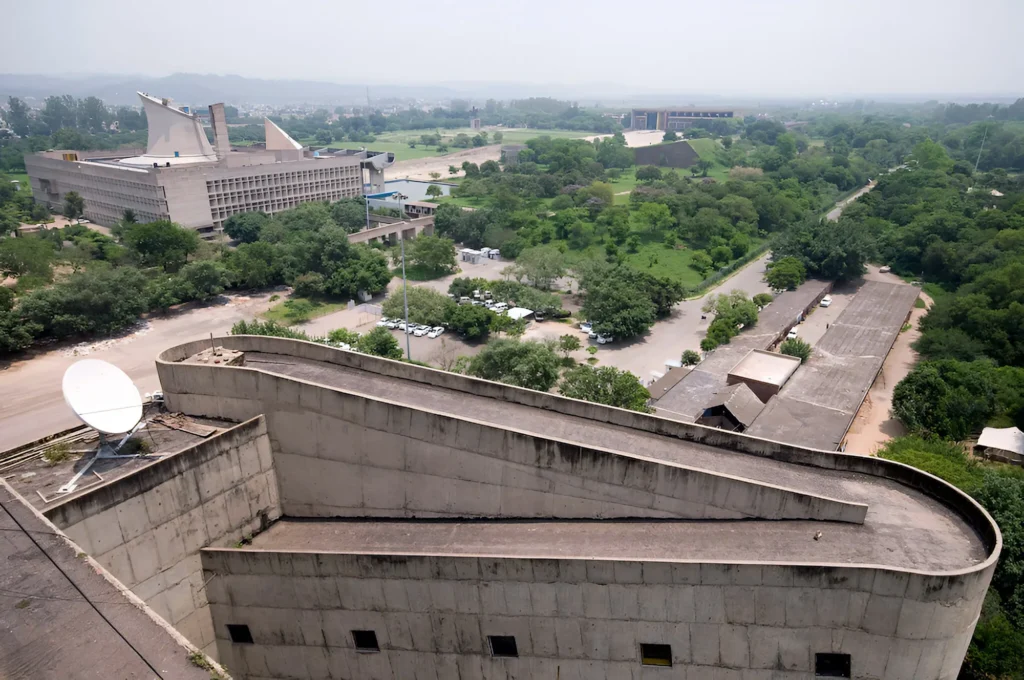The Spirit of Chandigarh’s Capitol Complex
- The Chandigarh Capitol Complex is more than just a cluster of government buildings lies in the heart of Chandigarh is a monumental testament to visionary architecture and urban planning. Designed by the legendary Swiss-French architect Le Corbusier, More than just a collection of government buildings, it is a powerful embodiment of modern architectural principles, a symbol of post-independence India’s aspirations, and a UNESCO World Heritage Site recognized for its exceptional universal value. For architects, historians, and anyone interested in the intersection of design and societal progress, the Chandigarh Capitol Complex remains an enduring source of fascination and study. The Chandigarh Capitol Complex declared a UNESCO World Heritage Site in 2016, the Capitol Complex remains one of the finest examples of modernist architecture in the world.
A Monument Born from Nehru’s Dream
- The monumental conceived as the nucleus of Jawaharlal Nehru’s dream city, the Chandigarh Capitol Complex encapsulates Le Corbusier’s urban planning theories and his distinct architectural vocabulary. Following India’s independence and the partition of Punjab, a new capital city was envisioned, one that would represent modernity and progress. Le Corbusier, a Swiss-French architect and pioneer of modern architecture, was entrusted with the master plan of Chandigarh, and the Chandigarh Capitol Complex became the jewel in its crown.
Chandigarh: A City That Inspired the World
- Chandigarh, even in the early 20th century, wasn’t just another city — it was the talk of forward-thinking architects and urban planners around the world. Visionaries like Peter Drucker and Frank Lloyd Wright admired it for its bold modernism and innovative design. But beyond its gridlines and greenery, Chandigarh stood for something bigger: a symbol of progress, hope, and a fresh start for a new India.
Le Corbusier’s Vision from 1950 to 1959
You know? Many people don’t realize that Chandigarh is the result of a visionary architectural project led by Le Corbusier between 1950 and 1959. The city’s most iconic feature, the Chandigarh Capitol Complex, isn’t just about striking buildings — it tells a story. Through powerful symbolism and modern design, it reflects India’s aspirations of unity, openness, and democratic ideals.
Let us explore the complex’s symbolism and charm in this blog.
An Overview of the Capitol Complex Chandigarh

Le Corbusier’s architecture of the Capitol Complex in Chandigarh is a complex, iconic design that symbolizes the nation’s independence movement. The complex consists of the Palace of Assembly, the Secretariat, and the High Court. The Palace of Assembly was designed to resemble a tent. It features a central tower rising high above the structure, which is flanked by two smaller towers on each side. The pillars are made out of steel and are intricately designed. The capitol building and secretariat building feature capitol domes and secretary domes respectively.
The Capitol complex Chandigarh is an important part of the city’s plan, which was drafted by Jawaharlal Nehru in 1952. The complex represents the excellent governance, culture, and architectural expertise of India’s independence movement. At its apex stands Le Corbusier’s Stalactite-and-Crowned-Butterfly House—a symbol of India’s sovereignty and indomitable spirit.
The Capitol Dining Table was created for the Palace of Assembly by Pierre Jeanneret and is an iconic design in itself.
The High Court and its Significance
Architectural Brilliance of the High Court Building
- The High Court Building of the Chandigarh Capitol Complex is a masterpiece of monumental and sculptural architecture celebrating the independence of India. The building is constructed with white-washed concrete and features complex geometric shapes that seem to float in the air above its four courtrooms. The entrance of the building bears a strong resemblance to the Buland Darwaza of Fatehpur Sikri, an architectural marvel built by the Mughal emperor Akbar. This structure is dominated by a huge archway crowned with a bulbous finial, which arguably marks the high point of Indian court architecture.
Capitol Complex Chandigarh’s High Court Geometric Precision in Design
- The design of the building is anchored by triangular regulating lines, which also play a significant role in shaping its geometry. These lines run across the length of the courtrooms and are used to divide each space into equal parts. This system allows for easy access and circulation within the court complex, while simultaneously highlighting the strength of imperious Indian judiciary.
Integration Within the Capitol Complex
- The High Court Building is located between other two court buildings of equal size, making it an integral part of the complex. Its dimensions are governed by modular combined with triangular regulating lines, thus conveying Le Corbusier’s vision of structural integrity supported by minimal and geometric forms.
A Lasting Legacy of Modern Indian Architecture
- The capitol complex has been hailed as one of India’s finest monuments and immortalizes Le Corbusier’s contribution to modern architecture.
The Assembly Building and its Meaning

Iconic Landmark of the Capitol Complex Chandigarh
- The Assembly Building is a prominent landmark in the Capitol Complex of Chandigarh, India. It is a visually striking piece of architecture with its dramatic cathedral-like silhouette and bright white exterior that brings chimes to mind. The building’s design was inspired by the Indian capitol complex of New Delhi, which it greatly resembles.
The Capitol Complex built in the 1950s as Punjab’s Legislature
- The Assembly Building was built in the 1950s as the new state legislature for the Indian state of Punjab. Though it has undergone some renovations over the years, the building’s modernist design still captures the essence of its time and place.
A Blend of Concrete and Natural Light
- The façade of the building features large expanses of glass that provide natural illumination and views of an expansive green lawn outside the building. The building’s structure is made up of reinforced concrete, which makes it sturdy and durable but also gives it an imposing solidity.
The Monument Capitol Complex’s Vibrant Interiors with Artistic Flair
- The interior halls and chambers are decorated with ornate furnishings and artworks, ensuring that legislative sessions are brighter, more vibrant, and celebratory than any could be imagined in a court house or Parliament hall elsewhere.
Symbol of Democratic Power and Respect
- The Assembly Building serves as a symbol of the importance and power of government in Chandigarh. It is a powerful reminder that one must respect government no matter who holds office because it ensures our freedom and safety .
A Peek into the Secretariat Building of Chandigarh’s Capitol Complex
The Secretariat Building – A Landmark of Governance
- The Secretariat Building of the Chandigarh Capitol complex is one of three structures that Le Corbusier and his cousin Pierre Jeanneret designed for the city’s capitol. The building is part of the Capitol Park, which stretches across the width of the city. The building stands out visually and physically from the rest of the city, embodying the dignity of the three fundamental powers of the two states of Punjab and Haryana.

Visit Details – The Secretariat Building, Chandigarh
- The building is home to offices, courtrooms, a legislative assembly, a museum, an auditorium, and other government facilities. It was built in 1972 and has a concrete frame with glass windows on the outer walls.
| Detail | Information |
|---|---|
| Address | The Secretariat Building, Capitol Complex, Sector 1, Chandigarh, 160001 |
| Entry Fee | Free (Photo ID required for access) |
| Visiting Hours | 10:00 AM – 5:00 PM (Monday to Friday) Exterior visits only on weekends |
Structure & Facilities – What’s Inside the Building
- The complex also includes residential areas in addition to several public spaces like gardens, lakes, walkways, playgrounds, and plazas. Visiting this complex will help you understand the importance of planning in developing urban areas and will give you an insight into Le Corbusier’s architectural style.
The Green Building Summit and its Impact
A complex and dynamic space, the Chandigarh Capitol Complex (CCC) is an exemplary modern architecture of ‘functionalism’ in India. Designed by Le Corbusier’s , the CCC’s three buildings are located towards the Shivalik Hills of Chandigarh. The complex has three wings—the present Legislative Assembly building, the secretariat building, and Chhajja Dharamsal—and a dome overshadowing it all. These structures are designed to provide ample spaces for judicial, legislative, and executive functions of government.
The Capitol Complex Chandigarh houses a large dining table designed by Pierre Jeanneret for the Palace of Assembly. It is supported by four curved legs that form a square base and two corkscrews to hold the table’s edges above ground level. A steel frame covers the top surface of the table with a glass plate as an additional covering layer.
The complex was designed to provide a calm site for the efficient functioning of these three pillars of democracy for the displaced Punjab government.
Architecture Talk with Le Corbusier’s Inspiration
Le Corbusier’s architectural works are renowned for their striking designs, cantilevered roofs and air circulation systems. He is known as the “father of modernism” because of his groundbreaking use of these features in his buildings.

The Capitol Complex in Chandigarh, India was designed by Le Corbusier and Pierre Jeanneret to provide a line of sight to the rest of the city, but the architect changed his plans to place artificial hills between the two buildings. The complex was built with Purism features such as geometric shapes and bright colors as well as Brutalism features such as reinforced concrete and angled roofs.
Following its completion in 1961, Le Corbusier’s praised the complex for its modernity, functionality, and sustainability. His architecture has been the subject of extensive analysis and research. Much of it looks at how he used different techniques such as Purism, Brutalism, and pre-stressed reinforced concrete in his works
News on the UNESCO Heritage Site
The Chandigarh Capitol Complex has recently been recognized as a UNESCO heritage site, making it one of the most important buildings in the country. The complex was designed by Le Corbusier in 1950 and is a complex of architectural monuments that symbolizes the emerging modern city of Chandigarh. It is one of the most prominent structures of modern architecture in the world, and its complex shape and boldness reflect Le Corbusier’s ideas on urban planning.
The complex was built to house the legislative assembly of Punjab and Haryana state. It consists of two buildings- the High Court building and the Legislative Assembly building-and an open space known as the ‘Plaza’. In recent years, both buildings have been restored to their former glory, but there is still a lot to be done before they are at their prime again. The complex is open to tourists and can be visited at Capitol Complex Tourist Centre, Chandigarh. Entrance is free for everyone.
Projects Inspired by Chandigarh Capitol Complex
The Vision Behind Chandigarh Capitol Complex
- Chandigarh Capitol Complex is a complex of buildings in the city of Chandigarh, India designed by the famous architect Le Corbusier and his cousin Pierre Jeanneret in the early 1950s. It stands out visually and physically from the rest of the city and embodies the dignity of the three fundamental powers – executive, legislative, and judicial. The complex includes a legislative assembly building (known as Assembly Hall), a high court building (known as Judicial complex), a governor’s palace building (known as Governor’s palace), a secretariat building (known as Secretariat), and other buildings. The landscape design for the complex included design for Assembly hall and orchard garden; these two were meant to reflect the rural ethos of Chandigarh.
Strategic Location & Natural Harmony
- The site at which the complex stands is strategically located at the geographic ‘head’ of the city against backdrop of Shivalik hills. This high-profile location makes it one of the important symbols of the city. Le Corbusier’s believed that buildings should be designed to blend in with their natural surroundings, rather than standing out as artificial structures.
An Icon of Modern Architecture
- The complex has been recognized for its architectural brilliance and aesthetic value. Its modern architecture has made it one of the most sought-after tourist destinations in India.
Le Corbusier’s Design Philosophy in Action
- The Chandigarh Capitol Complex is a true masterpiece of modern architecture. Its design is both simple and elegant, and it seamlessly blends in with its natural surroundings. The complex is a testament to Le Corbusier’s vision and skill as an architect, and it continues to inspire architects and designers around the world today. Le Corbusier’s was known for his meticulous attention to detail, and this is evident in every aspect of the complex.
The Role of Open Spaces
- One of the most striking features of the Capitol Complex Chandigarh is its use of open spaces. Le Corbusier’s believed that open spaces were just as important as buildings, and that they should be incorporated into the design of a complex. The Chandigarh Capitol Complex is a perfect example of this philosophy. The buildings are arranged around a large central plaza, which serves as a gathering place for visitors and locals alike. The plaza is also home to several fountains and sculptures, which add to its beauty and charm.
FAQ’s
What is Le Corbusier’s Chandigarh Capitol Complex?
Le Corbusier’s Chandigarh Capitol Complex is a masterpiece of monumental and sculptural architecture designed by the renowned architect Le Corbusier and his cousin Pierre Jeanneret in the early 1950s.
The complex consists of three buildings—the Palace of Assembly, the Secretariat Building, and the High Court—spread across the width of the city.
Le Corbusier envisioned the complex as a ‘parliament in the open air’, and it has been described by him as a ‘monumental work of architecture’.
What are the historical significance of Le Corbusier Chandigarh Capitol Complex?
Le Corbusier’s Chandigarh Capitol Complex was commissioned by Jawaharlal Nehru in the 1950s in post-colonial India. The complex was designed to celebrate the independence of a nation and reflects the dignity of the three fundamental powers. The complex occupies the compositional apex of the Chandigarh Plan and is the largest monumental complex designed and built by Le Corbusier.





